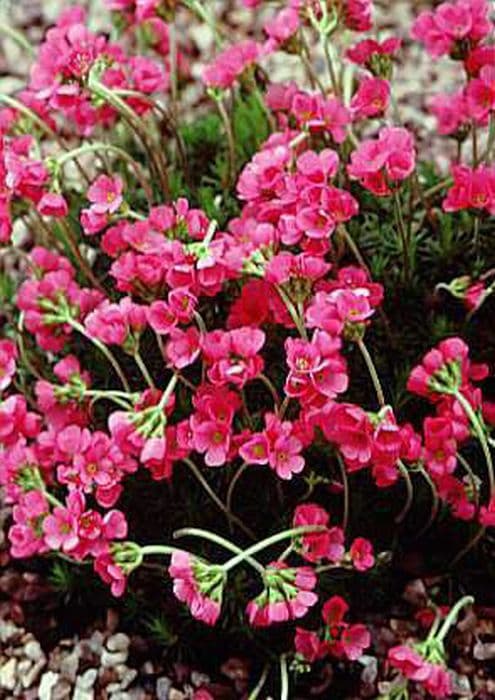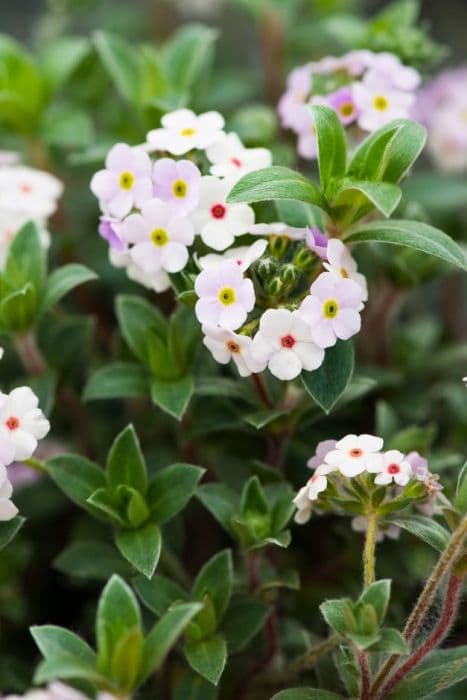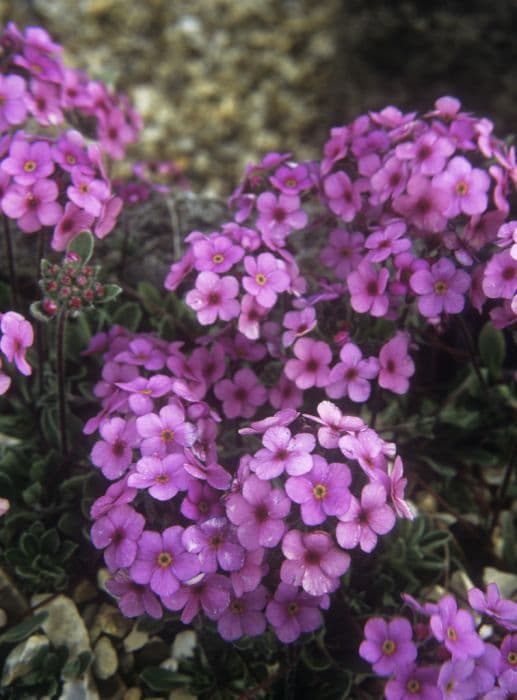Auricula Primula auricula 'Citron-ella' (Au/d)

ABOUT
The Primula auricula 'Citron-ella', commonly known as Auricula or Bear's Ear, is distinguished by its unique and vibrant appearance. The plant typically showcases tightly clustered rosettes of succulent green leaves which are somewhat waxy and smooth, creating a lush, compact backdrop for the flowers. The foliage may occasionally carry a powdery dusting that adds to its distinct look. The most captivating aspect of this plant is its flowers. Auricula 'Citron-ella' produces blooms that are strikingly ornate and colorful, possessing a bright, lemon-yellow hue that can brighten any garden space. The flowers are structured with a classic Primula form—rounded with a central tube—resembling miniature open faces peering upwards. They are often densely packed in clusters atop sturdy stalks that rise elegantly above the basal leaves. The texture of the petals is delicate and velvety, inviting close inspection. Each petal sometimes showcases a fine edge or margin of a different color, adding an additional layer of visual interest and complexity to the flower's appearance. These exquisite blooms can contribute a splash of cheerful color and a touch of elegance to any setting where they are grown.
About this plant
 Names
NamesFamily
Primulaceae
Synonyms
Auricula Primrose, Bear's Ear, Mountain Cowslip
Common names
Primula auricula 'Citron-ella' (Au/d).
 Toxicity
ToxicityTo humans
Bear's ear, as Primula auricula is commonly known, is not typically listed as a toxic plant to humans. There is limited information on its edibility or any toxic properties it may have. However, as with many plants, it is possible that some people could have a sensitivity or allergic reaction if they ingest it or come into contact with its sap. Symptoms of plant allergies or sensitivities can include skin rashes, itching, or irritation if touched, and nausea, vomiting, or diarrhea if ingested in large quantities. Therefore, while bear's ear is generally not considered poisonous, it is advisable to avoid ingesting any parts of the plant and to exercise caution if you have plant allergies.
To pets
Bear's ear, known scientifically as Primula auricula, is not typically considered toxic to pets. There is limited specific information regarding its toxicity to animals, but in general, the primula family can sometimes cause mild gastrointestinal upset if ingested. If a pet were to eat part of the plant, they might experience symptoms such as vomiting or diarrhea. As with any non-food plant, it is always better to err on the side of caution and prevent pets from ingesting it to minimize the risk of an adverse reaction.
 Characteristics
CharacteristicsLife cycle
Perennials
Foliage type
Evergreen
Color of leaves
Green
Flower color
Yellow
Height
6 inches (15 cm)
Spread
6 inches (15 cm)
Plant type
Herb
Hardiness zones
5
Native area
Europe
Benefits
 General Benefits
General Benefits- Ornamental Appeal: Auricula's vibrant and unique flowers bring aesthetic value to gardens and landscapes.
- Easy to Grow: This plant is known for being hardy and relatively easy to care for, which is beneficial for both novice and experienced gardeners.
- Long Blooming Period: Auriculas often have a longer blooming period, providing color and interest in the garden for an extended time.
- Container Gardening: Perfect for growing in pots or containers due to their compact size, making them ideal for balconies and small spaces.
- Attracts Pollinators: The bright flowers attract bees and butterflies, which are beneficial for pollination in the garden.
- Diversity: A wide variety of colors and forms allows for a diverse display in gardens or when used in floral arrangements.
 Medical Properties
Medical PropertiesThis plant is not used for medical purposes.
 Air-purifying Qualities
Air-purifying QualitiesThis plant is not specifically known for air purifying qualities.
 Other Uses
Other Uses- Primula auricula, commonly known as Auricula, can be used as a natural dye for fabrics, imparting a range of yellow to green hues depending on the mordant used.
- Auricula petals can serve as a subtle flavoring agent in salads and desserts for a slightly bitter, peppery taste, akin to the use of pansies.
- The leaves of the Auricula can be steeped in hot water to create a plant-infused foot soak that may have soothing properties.
- The Auricula is sometimes used in potpourri mixtures for its unique foliage and potential to retain color when dried.
- Artists and crafters might use pressed Auricula flowers to adorn greeting cards, bookmarks, or other handcrafted paper goods.
- This plant can add aesthetic value to green roofs where conditions are suitable, enhancing biodiversity and visual appeal.
- Auricula flowers can serve as natural indicators of soil pH; the flower colors can subtly change based on the acidity or alkalinity of the soil.
- The flower's unique shape has inspired designs in jewelry making, where it becomes a motif for earrings, pendants, and brooches.
- Used in the crafting of scented sachets, Auricula flowers can impart a mild fragrance to linens and clothing when placed in drawers or closets.
- In culinary presentations, the vibrant flowers of the Auricula can be crystalized and used as edible decorations on cakes and pastries.
Interesting Facts
 Feng Shui
Feng ShuiThe Bear's Ear is not used in Feng Shui practice.
 Zodiac Sign Compitability
Zodiac Sign CompitabilityThe Bear's Ear is not used in astrology practice.
 Plant Symbolism
Plant Symbolism- Rarity: Primula auricula, commonly known as Auricula or Mountain Cowslip, is a unique and less common variety, symbolizing rarity and uniqueness.
- Boldness: The bright and distinctive colors of Auricula 'Citron-ella' suggest a symbol of boldness and standing out in a crowd.
- Delicacy: Despite its striking appearance, Auricula 'Citron-ella' has a delicate structure, symbolizing fragility and the need for careful handling.
- Precision: The intricate patterns and shades of its flowers represent precision and attention to detail.
 Water
WaterThe Auricula Primrose should be watered regularly to keep the soil evenly moist but not soggy, approximately once every week with about 16 ounces of water. During hotter weather or if the plant is in a pot, it may require water more frequently. It's important to ensure the pot has good drainage to prevent root rot. Water directly at the base of the plant, avoiding wetting the leaves to prevent any fungal diseases. During the winter months, reduce watering to prevent over-watering as the plant goes into dormancy.
 Light
LightAuricula Primroses thrive in bright, indirect light; direct sunlight can scorch the leaves. They are best placed in a north-facing window or a spot that receives partial shade, especially in the heat of the afternoon. Providing the right amount of light can help maintain vibrant foliage and encourage blooming.
 Temperature
TemperatureAuricula Primrose prefers cooler temperatures and can survive minimum temperatures down to about 20°F for short periods. They perform best in a temperature range between 50°F and 75°F. Extreme heat or prolonged temperatures below freezing are detrimental to the plant’s health.
 Pruning
PruningPrune Auricula Primrose to remove spent flowers and encourage further blooming, typically after the flowering season in late spring or early summer. Deadheading spent blooms will also help prevent the plant from self-seeding. Pruning away any dead or damaged foliage is also necessary for plant health and aesthetics.
 Cleaning
CleaningAs needed
 Soil
SoilAuricula Primrose thrives in well-draining soil with high organic content. The ideal pH range for this plant is slightly acidic to neutral, between 6.0 and 7.0. A mix of peat, garden loam, and perlite or sand would provide the balance of drainage and fertility suited for this Primula.
 Repotting
RepottingAuricula Primrose should be repotted every one to two years. It's best done in the late winter or early spring before new growth begins, ensuring minimal disruption to the plant.
 Humidity & Misting
Humidity & MistingAuricula Primrose prefers moderate to high humidity levels, around 50-60%. These plants do well with a humid environment but must have good air circulation to prevent fungal diseases.
 Suitable locations
Suitable locationsIndoor
Place in bright, indirect light; ensure high humidity and good air circulation.
Outdoor
Plant in partial shade, shelter from harsh weather, well-draining soil.
Hardiness zone
4-8 USDA
 Life cycle
Life cycleThe Primula auricula 'Citron-ella', commonly known as auricula or bear's ear, initiates its life cycle through seed germination, typically occurring in a temperate climate with moist, well-drained soil. Following germination, the seedling stage is marked by the development of a rosette of leaves, a characteristic feature of the species. As the plant matures during its vegetative growth stage, it forms a compact, evergreen perennial clump. The auricula then enters its reproductive phase, usually in early spring, producing distinct, bright yellow flowers with a pleasant citrus fragrance. After pollination, typically by insects, the flowers will develop into seed capsules, containing numerous small seeds ready to disperse for the next generation. As a perennial, the Primula auricula 'Citron-ella' enters a period of dormancy during the colder months, only to resume growth and flowering in the following spring.
 Propogation
PropogationPropogation time
Spring-Early Summer
Primula auricula 'Citron-ella', commonly known as Auricula Primrose, is a herbaceous perennial that is most commonly propagated through division. The ideal time for division is in late summer to early fall, once the flowering season has ended. To propagate by division, carefully lift the parent plant from the ground and gently separate the clumps of crowns by either teasing them apart with your fingers or using a sharp, sterilized knife. Each division should have at least one shoot and a portion of the root system attached. Replant the divisions at the same depth they were growing at previously, spacing them about 6 to 8 inches (15 to 20 centimeters) apart to allow for adequate growth. Water the new divisions well to help establish them. This method encourages a quick return to flowering and is also an effective way to rejuvenate older plants that might have become too crowded.









